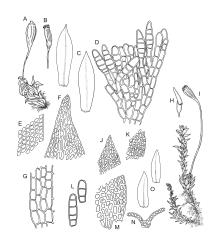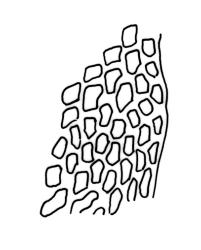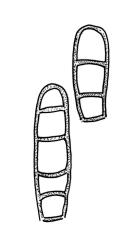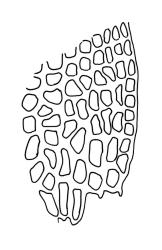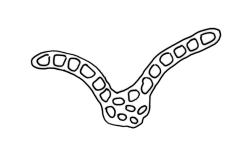- ≡ Codonoblepharon gracillimum (M.Fleisch) Matcham & O'Shea, J. Bryol. 27: 130 (2005) – as gracillimus
- = Zygodon rodwayi Broth. in Rodway, Pap. & Proc. Roy. Soc. Tasmania 1913: 260 (1914)
- = Zygodon subminutus Broth. in Dixon, Bull. New Zealand Inst. 3: 167 (1926)
Plants very slender, mostly c. 3–7 mm tall, forming dense tufts, yellow green, dull. Stems delicate, branched (mostly by subperichaetial or subperigonial innovation), in cross-section with almost uniformly thick-walled cells or rarely the central cells with ± thinner walls, central strand lacking; rhizoids present on lower stems, brown, finely papillose. Leaves loosely secund when dry, spreading or erect-spreading when moist, broadly lanceolate, acute (sometimes broadly so), entire or weakly crenulate, not decurrent, 0.3–0.6 × 0.1–0.2 mm; margins plane; upper laminal cells mostly rhombic but nearly quadrate at margins, thick-walled and smooth, not in oblique rows, mostly 6–12 × 6–9 μm; basal cells differing little or ± more irregular. Costa stout and scarcely tapered, ending below apex, yellow-brown in older leaves, mostly 36–45 μm wide and filling c. ⅓ the leaf base, the cells on both surfaces elongate. Gemmae borne in clusters on axillary stalks, clavate or filiform, with 3–8 transverse septa, 30–110 μm. Laminal KOH colour reaction positive yellow.
Dioicous. Perichaetia terminal, usually overtopped by innovations, with leaves larger (to c. 0.8 mm) than vegetative but otherwise similar. Perigonia terminal, usually subtended and overtopped by an innovation (and then appearing lateral), with c. 5 antheridia and filiform paraphyses; perigonial leaves broadly ovate and concave at base. Setae 3–5 mm, dextrorse, smooth; capsules exserted, narrowly obovoid from a long and slender neck, narrowed at mouth, becoming ± cylindric with age, deeply 8-furrowed throughout when dry, yellow- to red-brown at maturity, c. 1.0–1.2 mm; exothecial cells rectangular, in distinct thick-walled and thin-walled bands; stomata few, details not seen; annulus not seen; operculum short-rostrate from a conic base, c. 0.3 mm. Peristome double, sometimes with a fragmentary preperistome; exostome of 8 pairs of teeth, pale, reflexed when dry, irregularly papillose above, reticulate-papillose near base, c. 100 × 65 μm; endostome lacking a visible basal membrane, of 8 (or 16 fide Lewinsky) pale, linear, papillose-striolate segments which are c. ⅔ to ¾ the height of the teeth. Calyptra cucullate, fugacious (fide Lewinsky). Spores globose, rather coarsely papillose, 12.5–14 µm.
NI: N Auckland (Hukatere Scenic Reserve, Waipoua, Auckland City), S Auckland (Puaiti Bush, Thames, near Lake Rotoehu, Rotomahana, Pukerimu Bush, Whirinaki River Track), Gisborne (Hangaroa River), Hawke’s Bay (Balls Clearing),Wellington (Porirua, Wainuiomata–Orongorongo water catchment); SI: Nelson (Ōpārara River, Granite Creek), Westland (Kūmara, Gillespies Beach).
Anomalous. Recorded from Tasmania, Java, and Bolivia by Lewinsky (1990); this distribution is identical to that given by Malta (1926).
Zygodon gracillimus is usually an epiphyte on rimu (Dacrydium cupressinum) but numerous herbarium specimens specify collection from exposed roots of unspecified tree species. Collections have been seen from Myrsine salicina and Weinmannia racemosa and P. Beveridge (pers. comm., 15 May 2012) informs me he has collected it from Beilschmiedia tawa. An ample fruiting collection from Gillespies Beach formed a "spongy clump c. 12 cm diam. on [a] rotten tree in shady forest" and a collection from Kūmara was made from rock. Often growing in association with Orthorrhynchium elegans and Leratia obtusifolia. On the North I. from c. 100 m (Hukatere Scenic Reserve) to c. 760 m (Pukerimu Bush) and on the South I. from near sea level (Gillespies Beach) to c. 150 m (Ōpārara River). P. de Lange (pers. comm., 20 Feb. 2012) informs me that he has seen this species at North Cape (N Auckland L.D.) and on Mayor I. (S Auckland L.D.).
P. Beveridge (PB MA-3, CHR 611188) has collected aberrant material of Z. gracillimus at Porirua with abundant filaments in the leaf axils and also forming a dense mat, suggestive of a persistent protonema, at the base of the stems. However the filaments have transverse walls (unlike typical protonema), are strongly papillose, and appear to bear gemmae.
Confusion is most likely with Z. minutus, with the distinction between the two requiring microscopic examination to determine the length of the costae and stem anatomy details. Zygodon gracillimum appears to be a naturally uncommon species, but its highly inconspicuous nature and restricted habitat suggest that targeted searches might reveal a wider distribution.




